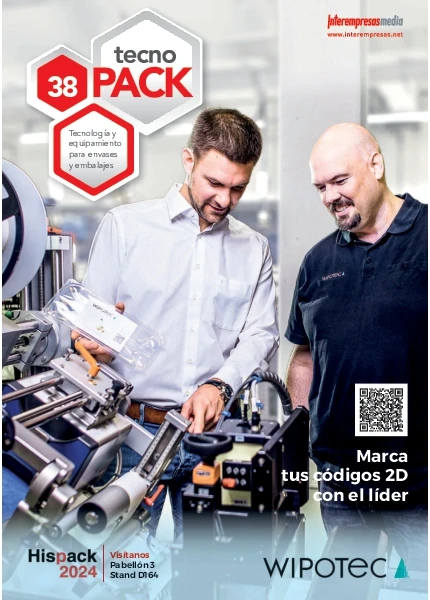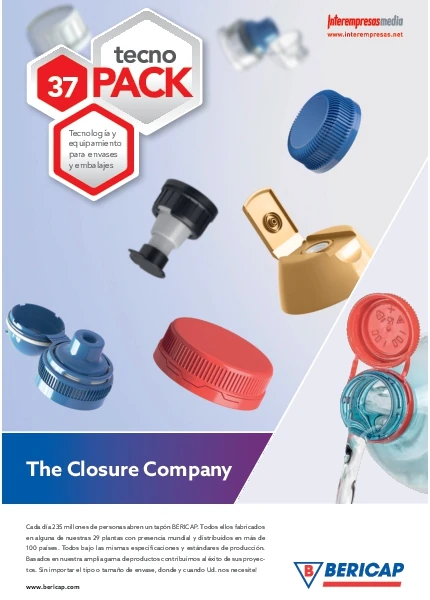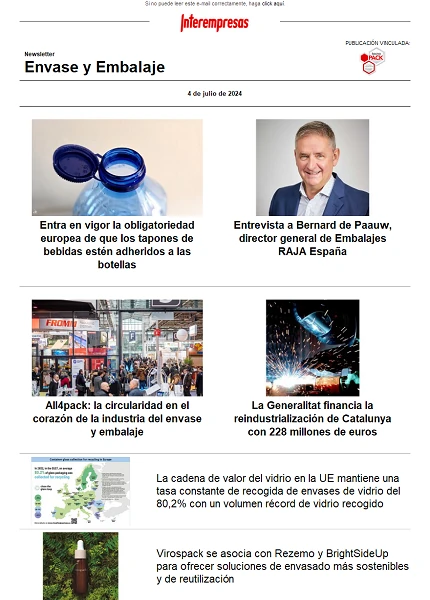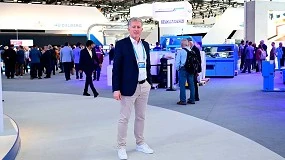Interview to Pedro Melgarejo, responsible of the line of business of Packs and Packaging in Aimplas
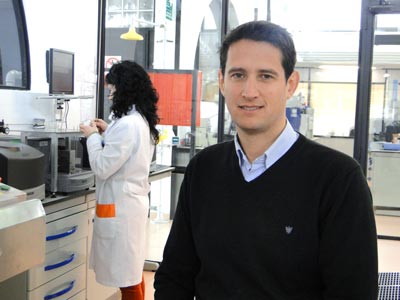
Alimentary and cosmetic container… each one with his different requests of hygiene. In bold strokes which are the differences between them?
The main difference between a cosmetic container and an alimentary container comes caused by the product that contains. In the case of an alimentary container, the product is, in the majority of the cases, a product that sees affected by numerous processes of degradation. These processes of degradation accelerate by environingingmental factors like the oxygen and the humidity, that cause the shortening of the useful life of the product packed. Although these effects can give in the cosmetics also, are much less pronounced, and do not arrive to cause so much shortening in the useful life of the cosmetic, in the majority of occasions.
When it speaks of plastic container knows that the main hándicap that this has is that it is not total barrier to these gases, and this is what confers that for each product and each speed of degradation of this, look for able materials to brake such effect of shortening of the useful life.
They exist more differences?
Himself. Another important difference between both containers is the control in hygiene to the consumer that at present exists. In the alimentary plastic container the measures of control in matter of alimentary hygiene are very demanding, at present the most strict in front of other materials in which at present they do not exist. In the field of the cosmetic, although they are initiating forums where this argues , still does not have of legislation regarding the substances that can transfer of the container to the product and cause toxiinfecciones in the user of the cosmetic, is a way for visiting in the next years.
Which lines of work are developing in the field of pack them barrier?
Two lines, mainly: One of them is the ecodiseño of the containers. It treats to improve the barrier of conventional materials to the different gases to avoid the presence of more structures of different plastics that do the difficult product to recycle after his use. A container has a greater cost of power in his cycle of life and back valorisation those that more different structures of plastic contain, and is here where are centring the efforts. A collateral effect to this line, and no less important, is the reduction of material, with the consequent of saving of costs for the transformer of containers, that each day more is presionado by the Channel Retail in this sense.
Already the second?
The biodegradable materials are another of the lines of investigation in the world of the container. The biodegradable materials, a priori and with an appropriate channel after his utilisation, are but respectful with the environingingment that the conventional materials. But at present they have like hándicap that do not have the same properties that the conventional materials. One of these properties that each day is improving is the barrier to the gases, with the consequent improvement in the packaging of perishable products that they are influenciados by the gases for his degradation organoléptica. Thanks to these new developments, each day there are biodegradable materials with better properties barrier.
It put examples again pack barrier, of which form will favour to the consumer?
In general, the new developments barrier direct in two senses: to adapt to the new processes of packaging, and to the improvement of materials that previously did not have this characteristic barrier. The first example that can put is the development of resistant plastic materials to processes of conservation based in high temperatures, as for example processes of sterilisation. they are developing New materials that contribute barriers and have a high resistance to the temperatures.
Another example is the improvement of the barrier in materials that historically have had low barrier, allowing the packaging of products with a material solo and improving the channel of recycled of this material after his use.
Lately the lines of investigation have gone headed to the active and intelligent containers, are solutions commercially viable or remain in the field of the investigation?
In effect, Are developing several products in this sense, but the majority of them still do not have a commercial reality. This is because of the legislative barrier that these products are finding . In the year 2009 appeared a legislation that allowed and regulated the trade of these containers, although inside this legislation is necessary that develop a list where will appear all the substances that will be able to use in this type of containers. When being containers that can transfer part of his structure to contribute to the conservation and improvement of the product packed, have to control with more rigour.
This appearance is the one who is delaying the apparition of these containers, since at present the European Commission is evaluating the studies of toxicity of the substances presented.
Nevertheless, exist two cases in which they can develop products without having to expect to the apparition of the listing of substances allowed for the manufacture of active and intelligent containers. One is the use of additives that are listed in the alimentary legislations. In this case yes they can use basing us in the marked restrictions in the alimentary legislations. Another case is the use of active and intelligent components after a functional barrier, that ensure of scientific way that through her does not exist risk of pollution of the alimentary product.
The day had specialists in legislation of international organisms, in general, which regulation govern the containers at present in Spain?
At present, the existent legislation in Spain of general form for the containers is the Regulation 1935/2004, this regulation mark establishes the generalities for all the materials in contact with foods. Specifically, it exists a legislation that hangs of this and is the Regulation 10/2011, that regulates the alimentary hygiene in the plastic containers.
In containers of other materials exists a big empty legal that is trying amend by part of the organisations and legislative bodies that for this have organised in diverse groups of work.

What differentiates there is regarding other countries? Some are more restrictivos?
In Europe, the legislation is harmonised for all the countries. With the presence of the European regulations, the fulfillment in all the countries of the European Union does homogéneo. Instead, in other zones is distinct the level of requirements that demands . An example is United States, where exists the FDA (Food and Drugs Asotiation) or Mercosur, where the requirements are different to which marks the reglamentación European. In each case is well analyse the product and verify the series of requirements for the commercialisation in a determinate zone.
The nanomaterials also have happened to play in first division, which paper exert and what future them augura?
The nanomaterials are one of the emergent technologies that better future has, but in the field of hygiene of the consumer have to surpass a series of exigencias. At present it is working a lot in this field, and have established some groups of work to determine a legal frame that ensure the correct use and the inocuidad in the consumption of products that have contact with them. In the present is not allowed the use for alimentary applications, by what the companies that devote to his development are working in looking for a frame regulatorio that allow that his products are a commercial reality.
The alimentary hygiene always has existed, but increasingly devote greater attentions, protocols… what thinks?
In effect, each day devote more efforts in this sense. Increasingly, the container considers like a critical element in the alimentary hygiene of the final product. In the happened the containers were considered like an independent element to the product that went to pack, but this concept is changing, by two motors: The first by the consumer, that each day demands a greater alimentary hygiene in the product packed. The second engine have been diverse alimentary alerts in which the precursor presumably has been the material of container. This has caused that in the present develop numerous legislations in this sense, and increasingly ranged to the principles of alimentary hygiene that apply him to the foods. In the MeetingPack will have opportunity to know the new challenges of legislation to which confronts the industry of the container, as well as to which will have to confront en el futuro, in a vision contributed by the main actors in the action to legislate on these products.
They will speak of legislative novelties in the sector of the plastic, what can advance us?
Yes, in effect there are legislative novelties, although I prefer that they advance them the brilliant speakers that will assist to the evento. As main novelties present the drafts of applicable legislations to materials of container, that at present do not have of legal frame that fulfil and hamper the market of the same. Also it will have special quotation all the legislation and current situation of the nanotechnologies in the alimentary world, that as we know is a big restlessness in this moment when treating of particles with some desconocimiento in his effects on the health, in front of his big potential in the improvement of the materials of packaging. Other novelties resaltables will go in the plane of the sustainability of container and in the gestión of his waste.
There is to day of today alternative materials that can compete with the plastics in the applications in which now impera the plastic?
To day of today, the plastic is the most versatile material to the hour to select or design new containers. In a study on the new launchings of product denotes a growth in this sense, situating with a near percentage to 40% of election of the plastic in the developments of containers for new products. This figure does us think that the plastic is adapting to the new requests of the market and situating as main alternative to other materials like the paper, the glass and the hojalata, that are losing market. One of the main reasons of this growth in the decision to choose this material is the improvement in the properties barrier of the plastics, main hándicap of the plastics historically. In the MeetingPack there is a big space headed to know the novelties in this sense, plastic alternatives to other materials, from the punto of the improvement in the functionality and the increase of the useful life of the products packed in them.
Which are the difficulties of the plastic recycled to win positions in the sector of the containers?
The plastic recycled is one of the big tendencies in the sector of the packaging. The regulation to European level has facilitated that the companies have begun with his use. From now they pose diverse challenges that the industry of the recycled is trying to surpass, as it is the homogeneity of the material, a key appearance to adapt this type of plastic to the processes of quality and to the specifications of final product that have the containers. Another challenge in which it is working a lot is in the improvement of the channels of recycled, that each day are more effective, with the increase of tonnes that this supposes.
Particularly in Spain, is waiting for the resolution of the European Commission in the permission of plants to be able to supply material recycled with total alimentary hygiene, although it has flexibilizado of transitory way with the reglamentación national this appearance for the sector of the containers for beverages.
By all this, presupposes that this alternative has a very consolidated future inside the containers, situating as a key road in the sustainability of our planet.
It observes a tendency to a greater utilisation of plastics more technical or is a sector that follows supporting mainly in commodities?
During the last decade has observed a clear increase in the utilisation of technical plastics, and even has appeared the concept of a packaging specific for each product, that has contributed to the apparition of new complexes and new forms of processed that increase the spectrum of materials used in container. Although in comparison to this increase, in the two last years has produced a frenazo by two reasons mainly: the first by the difficult situation that is suffering the economy, and the second by an increase in the awareness of sustainability, contrary to the idea of packaging with technical plastics, that in these moments do not have the channels of recycled very clear-cut.
All these questions will collect in the MeetingPack, by part of the main actors of the chain, that will show his experiences and his developments in the sector of the packaging. The conjoint organisation of this meeting by part of Aimplas and Ainia freamers inside the strategic alliance sealed from two years ago between both with the aim to offer global solutions to industries of the plastic, packs and packaging, alimentary and affine. It treats of an alliance that generates a big technological potential and that constitutes a European referent of first level in packs and packaging.


